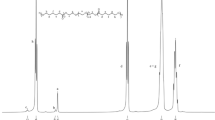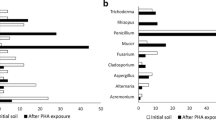Abstract
Various water-soluble homopolymers and copolymers of acrylamide (AAm) and acrylic acid (AA) which contained phenolic sites, such as guaiacol, lignin sulfonate (LS) and 3,4-dihydroxybenzoic acid (3,4-DHBA), were tested with regard to their degradability by white-rot fungi. Compared with Phanerochaete chrysosporium, Pleurotus ostreatus caused a significantly higher decrease in the average molecular weight (M̄w) of most of the copolymers and the homopolymer under the applied culture conditions. However, the M̄w of poly(guaiacol/AAm) increased significantly during incubation with Pl ostreatus. P. chrysosporium was able to reduce only the M̄w of the poly(LS/AA) to a significant degree and not that of the other polymers. The mineralization rate of AAm and AA copolymers and terpolymers of AAm, AA and phenolics (LS, 3,4-DHBA, guiacol), which were tested with P. ostreatus and Trametes versicolor, turned out to be low (0.8–3.2%). While the rates of mineralization were similar among all polymers, the decrease in radioactivity from the culture media was higher with the terpolymers bearing phenolic sites. UV spectra of the culture media revealed that the phenolic sites in the terpolymers were significantly degraded by both fungi. Obviously, the degradation of phenolics within the polymer chain caused a higher decrease in M̄w but did not significantly increase the mineralization rate.








Similar content being viewed by others
References
Bourbonnais R, Paice M (1990) Oxidation of non-phenolic substrates. An expanded role for laccase in lignin biodegradation. FEBS Lett 267:99–102
Call H-P, Mücke I (1997) History, overview and applications of mediated lignolytic systems, especially laccase-mediator-systems (Lignozym-process). J Biotechnol 53:163–202
Cameron MD, Post ZD, Stahl JD, Haselbach J, Aust SD (2000) Cellobiose dehydrogenase-dependent biodegradation of polyacrylate polymers by Phanerochaete chrysosporium. Environ Sci Pollut Res 7:130–134
Chen RL, Kokta BV, Daneault C, Valade JL (1986) Some water-soluble copolymers from lignin. J Appl Polym Sci 32:4815–4826
Childs RE, Bardsley WG (1975) The steady-state kinetics of peroxidase with 2,2′-azino-bis-(3-ethylthiazoline-6-sulfonic acid) as chromogen. Biochem J 145:163–202
Daneault C, Kokta BV (1986) The xanthan method of grafting. In: CE Carraher, LJ Sperling (eds) Renewable-resource materials: new polymer sources. Plenum, New York, pp 107–114
Dawes EA (1990) Novel biodegradable microbial polymers. (Proceedings of the NATO workshop on biodegradable polymers. NATO advanced science institutes series E: applied science 186) North Atlantic Treaty Organization, Brussels
ECETOC (1993) Polycarboxylate polymers as used in detergents. (Joint assessment of commodity chemicals report 23) European Centre for Ecotoxicology and Toxicology of Chemicals, Brussels
Fåhraeus G, Reinhammar B (1967) Large scale production and purification of laccase from cultures of the fungus Polyporus versicolor and some properties of laccase. Acta Chem Scand 21:2367–2378
Huang Y, Guozhen B, He S, Gao J (1992). Graft copolymerization of methyl methacrylate on stone ground wood using the H2O2–Fe2+ method. J Appl Polym Sci 45:71–77
Hüttermann A, Volger C (1973) Induction of arylglucosidase in Fomes annosus by cellobiose. Arch Microbiol 93:195–204
Kawai F, Hayashi T (2003) Biodegradation of polyacrylate. In: Matsumura S, Steinbüchel A (eds) Biopolymers. (Miscellaneous biopolymers and biodegradation of synthetic polymers, vol 9) Wiley, Weinheim, pp 221–299
Kharazipour A, Mai C, Hüttermann A (1998) Polyphenols for compounded materials. Polym Degrad Stabil 59:237–243
Kirk TK, Farrell RL (1987) Enzymatic “combustion”: the microbial degradation of lignin. Annu Rev Microbiol 41:465–505
Kirk TK, Schultz E, Connors W, Lorenz LF, Zeikus JG (1978) Influence of culture parameters on lignin metabolism by Phanerochaete chrysosporium. Arch Microbiol 117:277–285
Koshijima T, Muraki E (1968) Radical grafting on lignin. 1. Radiation-induced grafting of styrene onto hydrochloric acid lignin. J Polym Sci 6:1431–1440
Mai C, Milstein O, Hüttermann A (1999) Fungal laccase grafts acrylamide onto lignin in presence of peroxides. Appl Microbiol Biotechnol 51:527–531
Mai C, Majcherczyk A, Hüttermann A (2000) Chemo-enzymatic synthesis and characterization of graft copolymers from lignin and acrylic compounds. Enzyme Microb Technol 27:167–175
Mai C, Milstein O, Hüttermann A (2000) Chemoenzymatical grafting of acrylamide onto lignin. J Biotechnol 79:173–183
Mai C, Schormann W, Hüttermann A (2001) Chemo-enzymatically induced copolymerization of phenolics with acrylate compounds. Appl Microbiol Biotechnol 55:177–186
Mai C, Majcherczyk A, Schormann W, Hüttermann A (2002) Degradation of acrylic copolymers by Fenton’s reagent. Polym Degrad Stabil 75:107–112
Meister JJ (1988) An overview on polymers made from natural products. Proceeding of the symposium on biodegradable and other plastics. (Second national conference on corn utilization, St Louis, November 1988) Corn Growers Association, St Louis
Meister JJ, Patil DR (1985) Solvent effects and initiation mechanisms for graft polymerization on pine lignin. Macromolecules 18:1559–1564
Meister JJ, Patil DR, Channell H (1984) Properties and applications of lignin-acrylamide graft copolymer. J Appl Polym Sci 29:3457–3477
Meister JJ, Patil DR, Field LR (1984) Synthesis and characterization of graft copolymers from lignin and 2-propenamide. J Polym Sci Polym Chem Ed 22:1963–1980
Meister JJ, Lathia A, Chang FF (1991). Solvent effects, species and extraction method effects, and coinitiator effects in the grafting of lignin. J Polym Sci Polym Chem Ed 29:1465–1473
Milstein O, Gersonde R, Hüttermann A, Chen MJ, Meister JJ (1992) Fungal biodegradation of lignopolystyrene graft copolymers. Appl Environ Microbiol 58:3225–3232
Phillips RB, Brown W, Stannett VT (1972) The graft copolymerization of styrene and lignin. 2. Kraft softwood lignin. J Appl Polym Sci 16:1–14
Stahl JD, Cameron MD, Haselbach J, Aust SD (2000) Biodegradation of superabsorbent polymers in soil. Environ Sci Pollut Res 7:83–88
Sutherland GRJ, Haselbach J, Aust SD (1997) Biodegradation of crosslinked acrylic polymers by a white-rot fungus. Environ Sci Pollut Res 4:16–20
Acknowledgement
We are grateful to the Chemische Fabrik Stockhausen GmbH&Co.KG for all their help and financial support.
Author information
Authors and Affiliations
Corresponding author
Rights and permissions
About this article
Cite this article
Mai, C., Schormann, W., Majcherczyk, A. et al. Degradation of acrylic copolymers by white-rot fungi. Appl Microbiol Biotechnol 65, 479–487 (2004). https://doi.org/10.1007/s00253-004-1668-5
Received:
Revised:
Accepted:
Published:
Issue Date:
DOI: https://doi.org/10.1007/s00253-004-1668-5




